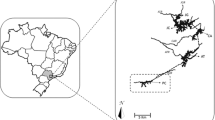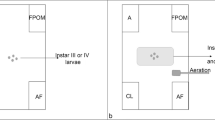Abstract
This experiment tested the effects of heavy metal contaminated sediment on emergence of chironomids. The number of adults emerging from test chambers containing an uncontaminated sediment and ones with sediment containing 1030 ppm cadmium (Cd), 17,300 ppm zinc (Zn), and 1640 ppm chromium (Cr) were observed for 14 days. It was found that emergence was reduced by over three times and delayed for two days in the heavy metal contaminated sediment.
Similar content being viewed by others
References
Macek, K., Buxton, K., Derr, S., Dean, J. & Saunter, S. 1976.Chronic toxicity of lindane to selected aquatic invertebrates and fishes. Eco. Res. Ser. EPA-600 J 3–76–046. 58 p.
Wentsel, R., McIntosh, A. & Atchison, G. 1977a. Sublethal effects of heavy metal contaminated sediment on midge larvae (Chironomus tentans). Hydrobiologipa. In press.
Wentsel, R., McIntosh, A., McCafferty, W. P., Atchison G. & Anderson, V.. 1977b. Avoidance response of midge larvae (Chironomus tentans) to sediments containing heavy metals. Hydrobiologia. In press.
Author information
Authors and Affiliations
Rights and permissions
About this article
Cite this article
Wentsel, R., McIntosh, A. & McCafferty, W.P. Emergence of the midge chironomus tentans when exposed to heavy metal contaminated sediment. Hydrobiologia 57, 195–196 (1978). https://doi.org/10.1007/BF00014573
Received:
Issue Date:
DOI: https://doi.org/10.1007/BF00014573




